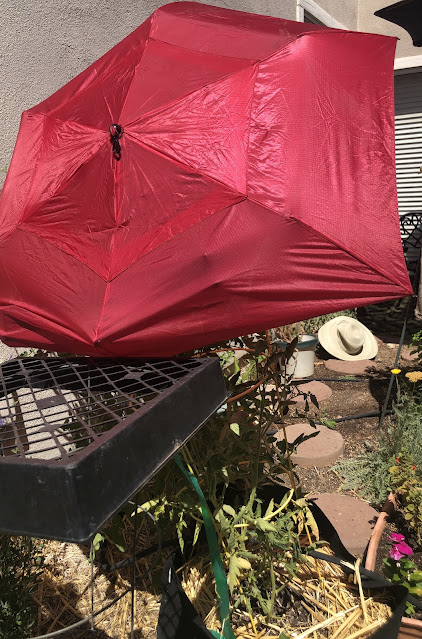
During summer heat, your garden appreciates mulch and morning irrigation

|
|
In addition to the red umbrella shading the tops of a
few tomato plants, how many shade hacks can you
find in this photo? There's the plant flat on a tomato
cage, the straw mulch in the grow bag, an old
summer hat shading the roots of a plant, and just a bit
of the shadows from a shade cloth and a patio umbrella.
That soil could use some more mulch, however. (Photo: Kathy Morrison) |
How is your garden handling the heat? Chances are your plants are faring better than you.
Which is a good thing – people can retreat indoors to air conditioning or at least a spot in the shade. Plants tend to stay in one place, no matter the temperature.
We appear to be in the midst of a record hot summer. According to the National Weather Service, Sacramento averages 23 days a year with triple-digit temperatures. As of Tuesday, Sacramento already had 19 100-plus days, with Wednesday and Thursday all but assured to reach 100 (or more). And this heat wave is not over.
“Temperatures will remain steadily hot into the next week with most days 5-10° above normal,” tweeted the Sacramento office of the weather service on Wednesday. “Hottest days will be today (Wednesday), tomorrow (Thursday) & early next week with Valley temperatures 100-105°. Practice heat safety! Find the forecast for your location at http://weather.gov/sto .”
Ouch! Fortunately, overnight temperatures remain “normal,” dipping down to about 60 degrees each night. That makes mornings automatically more comfortable.
* Get out early and irrigate as needed; some plants definitely will need some extra water.
* Plants with large thin leaves (such as hydrangeas or squash) tend to loose moisture during high heat. Afternoon wilting is normal for these floppy leaves; wilting in the morning is not.
* Container plantings dry out much faster than solid ground; give plants in pots a morning drink.
* If you haven’t already, slip some cardboard or wood under pots to keep their bottoms cooler.
* Organic mulch (leaves, straw, wood chips, etc.) acts as a cooling blanket over bare dirt. It insulates soil, conserves moisture and drops root temperature several degrees. That will comfort your plants during this heat wave and help them survive with less water, too.
* Dust tends to build up on leaves, adding to plant problems. (They can’t “breathe” if their stomatas – tiny pores on foliage – are clogged.) With a hose, give shrubs a morning shower to wash off dust and clean leaves. (It’s not wasting water; the plant will absorb the moisture and excess will run off to the soil and roots.) Do this in the morning so the leaves will dry off during the day.
* Watch for signs of sunburn. Erect temporary shade over tender plants such as peppers or eggplants if necessary. (See the photo above for ideas.)
* Deep-water trees and shrubs as needed. How can you tell if a tree is getting enough water? Look. Use a soil moisture meter to test soil along a tree’s dripline – the furthest reach of its foliage canopy – or try to plunge a long-handled screwdriver 6 inches into the ground. If the soil is like a brick, it’s time to irrigate.
Comments
0 comments have been posted.Sacramento Digs Gardening to your inbox.
Food in My Back Yard Series
April 29: What's (already) wrong with my tomato plants?
April 22: Should you stock up on fertilizer? (Yes!)
April 15: Grow culinary herbs in containers
April 8: When to plant summer vegetables
April 1: Don't be fooled by these garden myths
March 25: Fertilizer tips: How to 'feed' your vegetables for healthy growth
March 18: Time to give vegetable seedlings some more space
March 11: Ways to win the fight against weeds
March 4: Potatoes from the garden
Feb. 25: Plant a fruit tree now -- for later
Feb. 18: How to squeeze more food into less space
Feb. 11: When to plant? Consider staggering your transplants
Feb. 4: Starting in seed starting
Sites We Like
Garden Checklist for week of May 4
Enjoy this spring weather – and get gardening!
* Plant, plant, plant! It’s prime planting season in the Sacramento area. Time to set out those tomato transplants along with peppers and eggplants. Pinch off any flowers on new transplants to make them concentrate on establishing roots instead of setting premature fruit.
* Direct-seed melons, cucumbers, summer squash, corn, radishes, pumpkins and annual herbs such as basil.
* Harvest cabbage, lettuce, peas and green onions.
* In the flower garden, direct-seed sunflowers, cosmos, salvia, zinnias, marigolds, celosia and asters. (You also can transplant seedlings for many of the same flowers.)
* Plant dahlia tubers. Other perennials to set out include verbena, coreopsis, coneflower and astilbe.
* Transplant petunias, marigolds and perennial flowers such as astilbe, columbine, coneflowers, coreopsis, dahlias, rudbeckia and verbena.
* Keep an eye out for slugs, snails, earwigs and aphids that want to dine on tender new growth.
* Feed summer bloomers with a balanced fertilizer.
* For continued bloom, cut off spent flowers on roses as well as other flowering plants.
* Add mulch to the garden to maintain moisture. Mulch also cuts down on weeds. But don’t let it mound around the stems or trunks of trees or shrubs. Leave about a 6-inch to 1-foot circle to avoid crown rot or other problems.